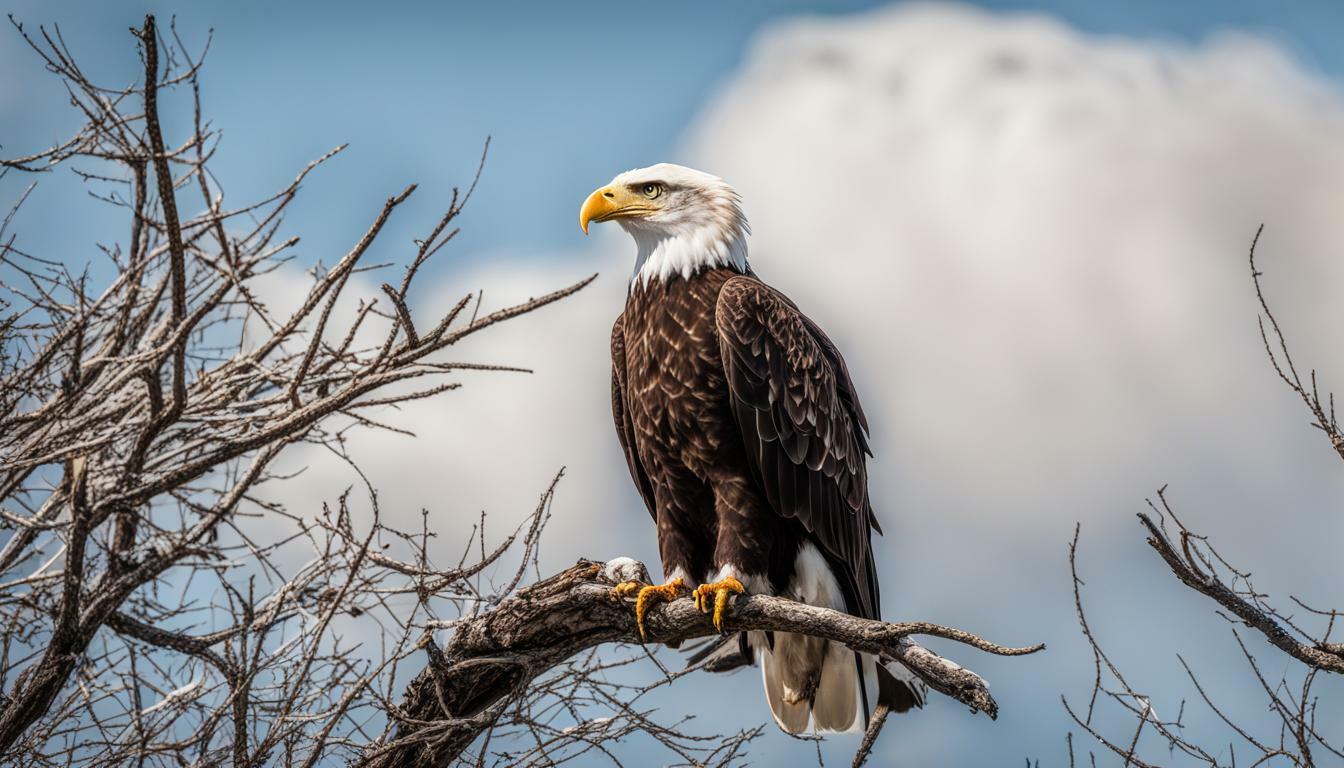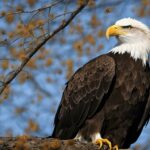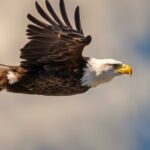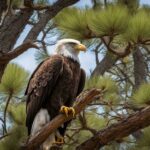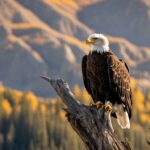As one of the most recognizable birds in the world, bald eagles have been a national symbol of the United States for centuries. Their majestic appearance and impressive wingspan have long captivated the imaginations of Americans, but many are curious about the color of their eyes.
So, what color are bald eagles eyes? In this article, we will explore the fascinating facts surrounding bald eagle eye color, including the natural color of their eyes, variations in eye color, adaptations for sharp vision, eye anatomy, changes in eye color with age, and the symbolism associated with their eye color.
Key Takeaways
- Bald eagle eye color is an area of interest for those fascinated by these majestic birds.
- The eye color of bald eagles has significant symbolism and represents their strength, wisdom, and connection to nature.
- Variations in bald eagle eye color are influenced by age, genetics, and environmental conditions.
- Their unique adaptations for sharp vision make bald eagles exceptional hunters and allow them to see long distances, spot prey underwater, and detect UV light.
- Bald eagle eye color can change with age, with juveniles having different eye coloration than adults.
The Natural Color of Bald Eagle Eyes
Have you ever wondered what color are bald eagles eyes? As one of the most revered national symbols of the United States, bald eagles have captured the fascination of many. While their distinctive white head and brown body are well-known, their eye color is less talked about.
The natural color of bald eagle eyes is a striking yellow. This color is due to the high concentration of pigment molecules called carotenoids in the eye’s iris. The bright and vivid yellow coloration is essential for their vision, as it helps to cut through the glare of sunlight and improve their ability to see their prey.
Bald eagles have an impressive vision that is at least four times more precise than that of humans. Their eyesight plays an essential role in hunting and survival. The yellow color of their eyes allows them to see better in low light conditions, which helps them to navigate through their habitat during dawn and dusk.
The Natural Color of Bald Eagle Eyes: Fact Box
| Eye Color | Pigment |
|---|---|
| Yellow | Carotenoids |
It’s important to note that the natural yellow color of bald eagle eyes can vary in tone and intensity between individual eagles. Factors such as age, genetics, and environmental conditions can influence the final coloration of their eyes. But overall, a bright and vivid shade of yellow is the most common color found in bald eagle eyes.
Variations in Bald Eagle Eye Color
While the natural color of bald eagle eyes is typically yellow, variations can occur based on a variety of factors. Age, genetics, and environmental conditions can all contribute to differences in eye coloration among bald eagles.
Young bald eagles have dark eyes that gradually lighten with age, typically becoming yellow by the time they are five years old. However, some eagles may retain a darker eye color even as adults.
Genetics also play a role in bald eagle eye coloration. Certain genetic variations can result in eagles with lighter or darker eyes than the typical yellow color. Additionally, environmental conditions such as diet and pollution can impact eye coloration, with some eagles developing orange or reddish eyes due to high levels of carotenoids in their food.
Overall, while the majority of bald eagles have yellow eyes, variations in eye coloration can occur based on a variety of factors. These unique differences make each bald eagle even more fascinating and worthy of admiration.
Adaptations for Sharp Vision
Did you know that bald eagles have some of the best eyesight in the animal kingdom? These majestic birds have a number of unique adaptations that enable them to have exceptional vision, which is crucial for their survival as predators.
One of the most impressive features of bald eagle eyes is their ability to see long distances. Their eyes are set far apart on their heads, providing them with a wide field of vision. Additionally, their eyes have a high density of cone cells, which are responsible for color vision and detail. This means that bald eagles can see fine details from far away, making them skilled hunters.
Bald eagles are also able to spot prey underwater. They have a clear inner eyelid, called a nictitating membrane, which acts as a protective layer when they dive into water. This membrane also helps to refract light and enhance their vision underwater.
Another unique adaptation of bald eagle eyes is their ability to detect UV light. Their eyes have a specialized cone cell that can detect ultraviolet light, which is invisible to humans. This allows bald eagles to see patterns and markings on prey that are invisible to us.
Overall, these adaptations make bald eagles some of the most skilled hunters in the animal kingdom. Their sharp vision, combined with their powerful talons and beaks, make them formidable predators.
Eye Anatomy of Bald Eagles
Understanding the anatomy of a bald eagle’s eye provides insight into why they have exceptional vision and unique eye coloration. A bald eagle’s eye is larger than a human eye and can weigh almost as much, making up about 5% of its total body weight.
| Part of the Eye | Description |
|---|---|
| Cornea | A clear, dome-shaped outer layer that covers the eye and helps focus light. |
| Pupil | The black circular opening in the center of the eye that controls the amount of light entering the eye. |
| Iris | The colored part of the eye surrounding the pupil that controls the amount of light entering the eye. |
| Lens | A clear structure behind the iris that focuses light onto the retina. |
| Retina | A thin layer of tissue at the back of the eye that contains photoreceptor cells that detect light. |
| Optic Nerve | A bundle of nerve fibers that carries visual information from the retina to the brain. |
Bald eagles have a specialized layer behind their retina called the fovea centralis, which is densely packed with photoreceptor cells. This layer enables them to have sharp central vision and be able to spot prey from a distance. Additionally, their eyes are able to adjust their focus quickly to compensate for changes in distance, allowing them to see clearly both near and far.
Eye Color Changes with Age
As bald eagles mature, their eye color can change. Juvenile eagles typically have brown eyes, which later turn yellow as they reach adulthood. The exact timing of this change can vary, but it usually occurs around 4 to 5 years of age.
One reason for this change is the accumulation of a pigment called lipochrome, which causes the eyes to shift from brown to yellow. Additionally, as eagles age, their iris becomes thinner, allowing more light to enter and giving their eyes a brighter appearance.
It’s important to note that not all bald eagles follow this pattern. Some individuals may retain brown eyes throughout their lifetime, while others may have eyes that appear more gray than yellow. Environmental factors, genetics, and nutrition can all play a role in these variations.
Regardless of their eye color, bald eagles’ keen eyesight is key to their survival and success in the wild. Their ability to spot prey from great distances and detect UV light helps them navigate their environment and hunt effectively.
Eye Color in Juvenile Bald Eagles
Have you ever wondered why juvenile bald eagles have different eye colors from adult ones? Here’s what you need to know:
Young bald eagles have dark brown eyes that gradually lighten as they mature. It can take up to five years for their eyes to reach the distinctive yellow color of adult bald eagles. This color change is due to a process called “iris lightening,” which occurs as the bird ages.
During the first year of their life, juvenile bald eagles go through a series of transformations, including changes in their eye color. At first, their eyes are a deep brown color, which can make them appear less intimidating to potential predators. As they grow older, their eye color lightens to a yellow hue, which provides better visibility for hunting and gives them a more intimidating presence.
Interestingly, the timing of the eye color change can vary based on the bird’s geographic location and seasonal changes. For example, bald eagles in northern regions tend to have lighter eyes than those in southern regions.
Overall, the changing eye color of juvenile bald eagles is just one of many fascinating aspects of these remarkable birds. Whether they have brown or yellow eyes, these majestic creatures continue to captivate us with their strength, wisdom, and connection to nature.
The Symbolism of Bald Eagle Eye Color
You may be wondering why there is such fascination with the color of bald eagle eyes. As a national symbol of the United States, the bald eagle represents strength, wisdom, and connection to nature. Their piercing gaze and powerful vision have captivated people for centuries. The color of their eyes is not only fascinating, but it also holds great symbolic meaning.
The striking yellow color of a bald eagle’s eyes represents their strength and power. Yellow is often associated with the sun and the energy it provides, as well as with happiness, optimism, and enlightenment. The bold color of their eyes reflects the boldness and resilience of this magnificent bird.
Furthermore, the sharpness of a bald eagle’s vision is closely tied to their wisdom and intelligence. Eagles are known for their keen eyesight, which allows them to spot prey from great distances and even underwater. The ability to see clearly and gather information from their surroundings is a symbol of intelligence and wisdom.
The connection to nature embodied by the bald eagle is also reflected in the color of their eyes. The deep, rich color of their pupils signifies their connection to the natural world and the importance of environmental preservation. Bald eagles are a reminder of the beauty and power of nature and our responsibility to protect it.
In conclusion, the color of bald eagle eyes holds great significance and symbolism in American culture. The powerful yellow hue reflects their strength and resilience, while their sharp vision represents their wisdom and intelligence. Their eyes are a reminder of our connection to the natural world and the importance of preserving it for future generations.
Section 9: Conclusion
Now that you have delved into the world of bald eagle eye color, you have gained a deeper understanding of these birds and their fascinating adaptations. From the natural color of their eyes to the variations seen among different individuals, bald eagle eye color is a complex and intriguing topic.
As you have learned, the sharp vision of bald eagles is crucial for their hunting and survival, and their ability to see long distances and detect UV light is truly remarkable. The changes in eye color that occur as they age and mature, as well as the symbolism associated with their eye color, add to the allure and mystique of these powerful birds.
We hope this article has provided you with a newfound appreciation for bald eagles and their captivating eye color. Whether you are an avid birdwatcher, a nature enthusiast, or simply curious about these majestic creatures, the color of their eyes is just one piece of the puzzle that makes them so remarkable.
Are Bald Eagles Protected in Florida and What Are the Regulations?
Bald eagle protection laws in florida are in place to safeguard these majestic birds. The federal Bald and Golden Eagle Protection Act and the Migratory Bird Treaty Act both extend their protection. In Florida, it is illegal to harm, disturb, possess or even collect their feathers without proper permits. These regulations ensure the preservation of these iconic creatures.
Are Bald Eagles Considered Pet Birds? How Hard Are They to Take Care Of?
When it comes to understanding pet bird care, it is important to know that bald eagles are not considered suitable as pet birds. These majestic creatures are protected by law in the United States, making it illegal to keep them as pets. Additionally, bald eagles require a highly specialized care regimen due to their wild nature, specific diet, and need for a large living space, making them incredibly hard to take care of domestically.
FAQ
Q: What color are bald eagle’s eyes?
A: The natural color of bald eagle’s eyes is a striking yellow. This color is thought to provide excellent visibility for hunting and navigating their environment.
Q: Do bald eagle eye colors vary?
A: Yes, bald eagle eye colors can vary. Factors such as age, genetics, and environmental conditions can contribute to variations in eye coloration among bald eagles.
Q: How does bald eagle eye color change with age?
A: Juvenile bald eagles typically have darker eye colors, such as brown or gray, that gradually transition to the iconic yellow color as they mature into adulthood.
Q: What adaptations do bald eagle eyes have for sharp vision?
A: Bald eagle eyes are adapted for exceptional vision. They have keen eyesight that allows them to see long distances, spot prey underwater, and even detect ultraviolet light.
Q: What is the symbolism of bald eagle eye color?
A: The color of bald eagle’s eyes represents their strength, wisdom, and connection to nature. It is one of the factors that contribute to their status as a powerful national symbol.

